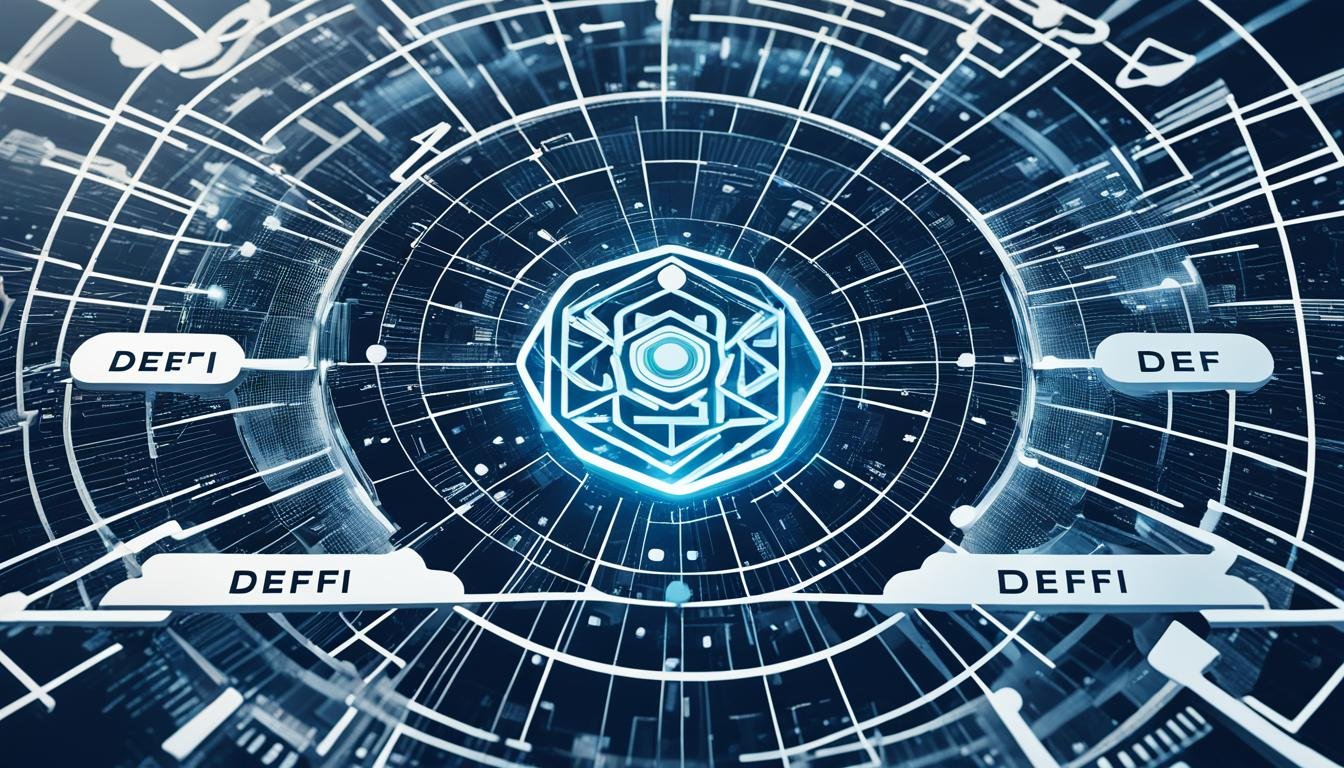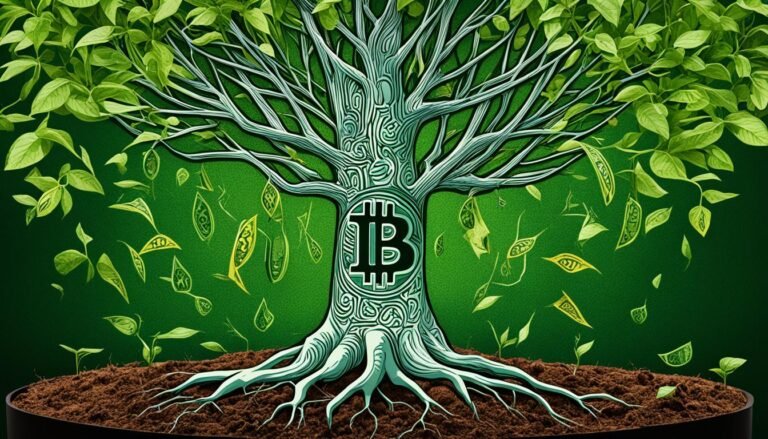Decentralized Finance (DeFi): Revolutionizing Finance
Did you know that only 0.56% of all money is in cryptocurrency and DeFi? This small amount could change the financial world. DeFi uses blockchain to cut out the middlemen. This makes financial dealings more open and lets people control their money.
DeFi relies on crypto, blockchain, and smart software for its services. It makes deals direct between users, without the need for third parties. This new way of investing is altering how we view finance and the tech behind it.
Key Takeaways
- ${DeFi
- only represents 0.56% of total money, yet its impacts are profound.
- ${DeFi
- platforms offer low fees and high interest rates.
- ${Blockchain
- technology ensures secure and immutable ledgers for ${DeFi
- transactions.
- ${DeFi
- eliminates the need for traditional financial intermediaries.
- ${Peer-to-peer
- systems empower direct and autonomous financial transactions.
- The ${DeFi
- sector holds around $55 billion in crypto assets.
Introduction to Decentralized Finance (DeFi)
Decentralized Finance, known as DeFi, is a big step towards finances being more spread out. It changes how we think about money from just the way big institutions handle it. DeFi uses new tech like blockchain to let people trade and invest without the usual finance systems.
DeFi lets people do financial things directly with each other. This means less need for big banks and other middlemen. It cuts costs and makes finance more open around the world.
With the help of blockchain, DeFi keeps everything secure and clear with smart contracts. These contracts run by themselves and are a new way to make sure deals are fair. They also keep people’s names secret for privacy.
Right now, not much money is in DeFi and cryptocurrency. Just 0.56% of all money is in these new types of finance. But, more and more people are getting into it, with billions of dollars already invested.
DeFi has its challenges too. It’s still figuring out laws and can be a target for hackers. People need to be careful and understand the risks, like smart contract mistakes and the danger of losing money because regulation is not fully there yet.
Components of DeFi
Decentralized Finance (DeFi) revolves around three key parts: Blockchain Technology, Cryptocurrencies, and Smart Contracts. Each part has a specific job. They work together to make DeFi a system that is open, secure, and clear for everybody.
Blockchain Technology
At its heart, DeFi uses Blockchain Technology. This tech is like a giant, shared, and unchangeable book for all transactions. It makes sure everything is safe and can’t be changed later. This trust it creates is why we can do finance without middlemen.

Cryptocurrencies
Cryptocurrencies are the digital cash of DeFi. They include tokens that represent different assets. With these, people can invest, lend, or provide funds to earn interest. They’re also used for buying and selling online, making DeFi a lively place.
Smart Contracts
Ethereum’s Smart Contracts are the cool, new thing in DeFi. These special contracts can do their job without people needing to watch over them. They handle things like loans, managing assets, and other money deals automatically.
| Component | Function | Examples |
|---|---|---|
| Blockchain Technology | Ensures secure, immutable transactions | Ethereum, Avalanche |
| Cryptocurrencies | Digital mediums of exchange and store of value | Bitcoin, Ether |
| Smart Contracts | Automate and enforce financial agreements | Aave, Chainlink |
How Decentralized Finance (DeFi) Works
Decentralized Finance (DeFi) changes the way we think about money. It does this by cutting out the middlemen. This section will talk about how DeFi uses peer-to-peer networks, strong security, and gets rid of the go-betweens.
Peer-to-Peer Financial Networks
DeFi lets people connect directly to trade money. They don’t need banks or other third parties. Instead, they use special online places like Uniswap and PancakeSwap. These sites let people easily swap different cryptocurrencies.
In these places, some people add their money to the system. This helps everyone trade more easily. They might even make some money back by doing this.
Security Protocols and Software
Keeping DeFi safe is very important. Strong digital locks and smart software keep bad things from happening. But because DeFi is new, it’s still learning how to stay safe. This means problems like hacks can happen.
Over time, DeFi’s safety locks will get better. This makes the whole system more trustworthy and safer to use.
Eliminating Intermediaries
DeFi wants to let people trade directly without anyone else involved. This saves on extra costs. It also opens up trading to more people.
But, not having any middlemen makes it harder for the government to keep an eye on things. This can cause problems with making sure everyone follows the rules.
Even with these issues, DeFi is working to make finance more fair. It wants to give everyone a better chance to use and earn money.
Key Applications of DeFi
Decentralized Finance (DeFi) has introduced new financial ideas. These include DEX trading, smart contract lending, and more. They give new chances in banking, trading, and managing money online.
Decentralized Exchanges (DEXs)
DEXs are changing how we trade digital money. They don’t need traditional banks. This keeps trades safe and private. Popular DEXs like Uniswap show how powerful this type of trading can be.
Peer-to-Peer Lending
Peer-to-peer lending links borrowers with lenders directly. This system uses smart contracts to help people borrow or loan out digital money. It makes earning interest fair and safe.
Yield Farming and Liquidity Pools
Yield farming lets people earn rewards by lending digital assets. This helps the DeFi system work better. By doing this, people can make more from their digital money.
DeFi is making big changes in finance. It’s offering new choices that make banking and trading more open. As it grows, we can expect even more ways to use DeFi in the future.
Smart Contracts in DeFi
Introduced by Nick Szabo in the 1990s, smart contract technology is a key part of DeFi. These contracts work on platforms like Ethereum. They get rid of the middleman, making transactions more direct and secure. Automated compliance is achieved through the use of coded rules.
There are many types of smart contracts in DeFi. For example, Compound and Aave use them for lending and borrowing. Uniswap and SushiSwap use them for direct trading. Yearn.finance improves yield farming with smart contracts. Nexus Mutual even offers insurance against risks.
These smart contracts also allow for assets to be tokenized. This means you can own parts of real-world assets. With over $100 billion in stablecoins, these processes are getting more common and safe.
| Platform | Type of Contract | Service Offered |
|---|---|---|
| Compound | Lending and Borrowing | Peer-to-Peer Lending |
| Uniswap | DEX | Direct Cryptocurrency Trading |
| Yearn.finance | Yield Farming | Optimizing Yield Strategies |
| Nexus Mutual | Insurance | Coverage Against Contract Risks |
DeFi uses networks that are open and free from censorship. This makes finance available to more people worldwide. However, there are risks like bugs in the code and faulty data. Still, DeFi smart contracts hold over USD $20 billion. This shows trust and growing use in these technologies.
The Role of Stablecoins and NFTs in DeFi
Decentralized finance (DeFi) brought many new ways to manage money online. This includes digital stablecoins and NFTs. Stablecoins aim to keep a steady value to help with big price changes. NFTs change how we invest and make digital things valuable in the DeFi world.
Stablecoins for Price Stability
Digital stablecoins are a key part of DeFi, worth over $100 billion. They link their value to things like regular money or gold. This helps keep the market stable. Their steady value is key for trading on places like SushiSwap or Uniswap, which are growing fast.
Non-Fungible Tokens (NFTs)
NFTs offer a new type of digital ownership and investment. They make unique assets like art or virtual plots of land. NFTs also include crypto collectibles, showing their value and potential for good returns.
Both stablecoins and NFTs show how DeFi is changing finance. They use smart systems and secure methods for various financial actions. This makes a strong and active digital financial market.
Benefits and Risks of DeFi
DeFi is changing the finance world with new, secure options for everyone. It focuses on DeFi security and DeFi transparency. This new way of doing things makes finance more open and fair. But, it’s important to watch out for blockchain risks and follow the rules.
Security and Transparency
DeFi is all about being open and safe thanks to blockchain. This tech tracks all dealings, which makes cheating harder. Smart contracts let people check the laws themselves, which builds trust in DeFi.
Financial Inclusion and Accessibility
DeFi opens the door to finance for people left out before. It lets anyone borrow, lend, or trade without banks. This helps more people join in the financial world.
Risks: Hacks and Regulation Issues
DeFi comes with dangers, like bugs in the system and big hacks. Also, there are many rules DeFi must follow. Governments want to protect investors while letting new ideas grow. Striking this balance is key for DeFi’s future.
| Year | Estimated Market Size | Total Locked Value | Number of Users |
|---|---|---|---|
| 2022 | $13.61 billion | $52 billion | – |
| 2024 | $26.17 billion | – | – |
| 2028 | – | – | 22.09 million |
DeFi in Real-World Contexts
DeFi isn’t just a big idea. It’s making a real difference in things like money transfers and how products get to us. Its use in everyday life shows it could change the way we do things.
Reducing Costs
DeFi makes sending money cheaper. When people send money to their families in other countries, they usually get charged a lot. DeFi cuts these costs down by half or more. It does this by directly connecting people, without the need for banks in the middle.
Supply Chain Management
In how stuff gets made and reaches us, DeFi is a big plus too. It uses the power of blockchain to make things clear and easy to track. This makes it cheaper to move goods and money around, and it all happens faster. No more waiting for people to do things by hand.
The use of DeFi goes beyond just these few examples. It’s taking on a lot of different tasks in a lot of different places. With over $55 billion being put into DeFi, projects like Uniswap and Aave are leading the way. They are showing us just what DeFi can do.
Conclusion
Decentralized Finance (DeFi) marks a turning point in finance worldwide. It uses blockchain to offer a fair and open financial world. Here, people can trade with others worldwide, breaking free from the old limits set by location and big players.
Platforms like Uniswap and PancakeSwap have become popular, showing DeFi’s bright future. This is despite some weaknesses right now.
DeFi has many uses. People can lend money or farm for profits on places like Aave and Compound. There are also new ways to get insurance, thanks to Nexus Mutual. But, DeFi is new, so it’s still learning to face up to rules and security worries.
Thanks to advanced security and honest contracts on platforms like Ethereum, these risks are getting smaller. This tech works hard to keep transactions safe and fair, making sure people’s experiences are smooth.
But, cryptocurrency and DeFi make up just a tiny bit of the whole money system – around 0.56%. Still, their effect on how we do finance is huge. Making DeFi safe and stable in the long run needs solving things like market swings and managing risks better.
By working on new ideas and watching things closely, DeFi brings big hope. It wants to change how we handle money, making it open to all. The future of decentralized finance is thrilling and full of promise.
Source Links
- https://www.investopedia.com/decentralized-finance-defi-5113835
- https://thepaymentsassociation.org/article/decentralized-finance-defi-revolutionizing-the-financial-landscape-through-blockchain-technology/
- https://brave.com/web3/what-is-defi/
- https://www.forbes.com/advisor/investing/cryptocurrency/defi-decentralized-finance/
- https://www.chain.link/education-hub/defi-ecosystem
- https://www.brookings.edu/articles/cryptocurrencies-and-decentralized-finance-defi/
- https://aws.amazon.com/blockchain/what-is-defi/
- https://medium.com/@MiSon_Finance/what-are-the-roles-of-smart-contracts-in-defi-bd7341c9e018
- https://chain.link/education/defi
- https://coinmarketcap.com/alexandria/article/a-dive-into-smart-contracts-and-defi
- https://sdlccorp.com/post/the-role-of-metaverse-and-crypto-in-decentralized-finance/
- https://www.stackpath.com/edge-academy/what-is-decentralized-finance-defi/
- https://www.quytech.com/blog/decentralized-finance-business-guide/
- https://www.bis.org/publ/qtrpdf/r_qt2112b.pdf
- https://itsa-global.medium.com/real-world-assets-in-defi-driving-mainstream-adoption-of-decentralized-finance-f9417f546a50
- https://www.linkedin.com/pulse/rise-decentralized-finance-defi-exploring-future-systems-nuseibeh





